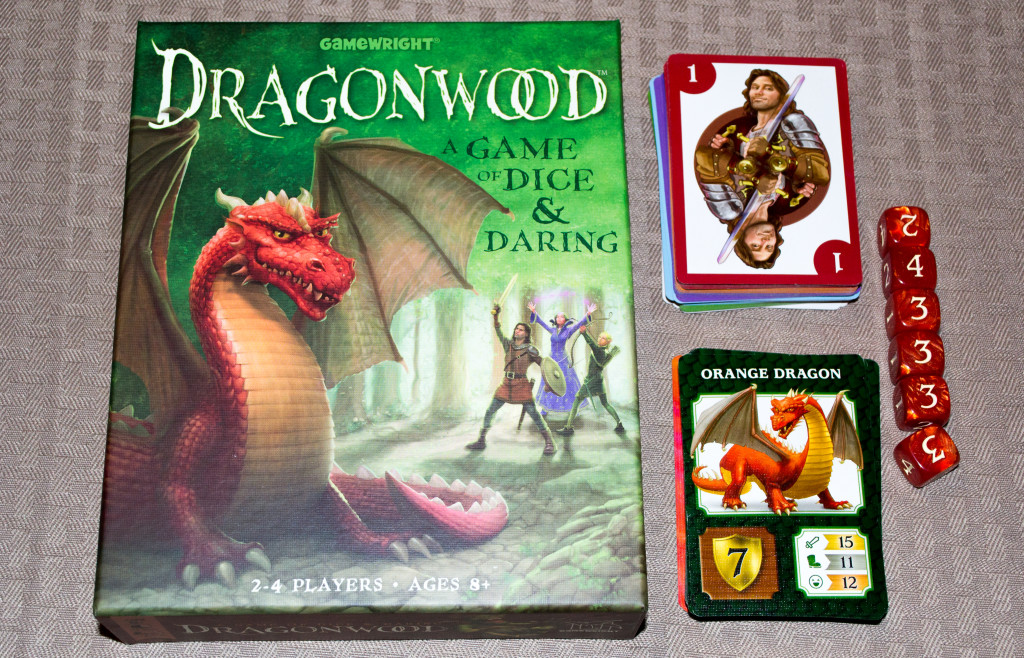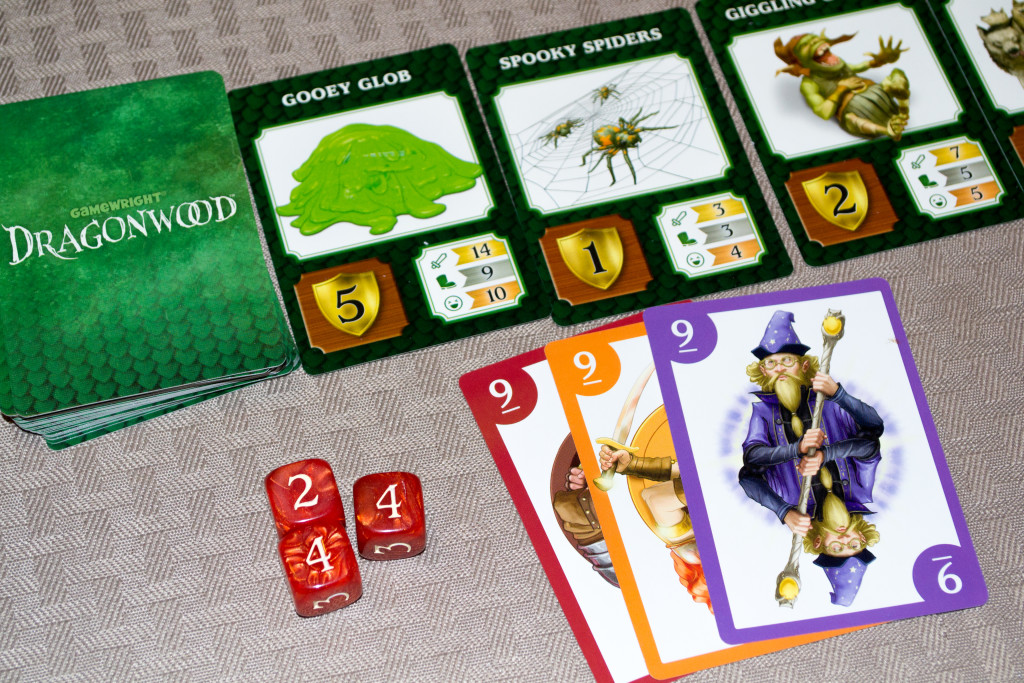So it’s been established that you like to kill dragons and other mythical creatures, but you don’t have the time to play for hours delving through dungeons in order to do it. Well, what if you based “combat” entirely around card tricks (straights, pairs, flushes, etc.) and simplified the game to the point where it only takes twenty minutes to play? Enter “Dragonwood”, a game that features all of these things (and more). Before I elaborate on that however, I’d like to thank Marketing Coordinator Nora Meiners from Ceaco/Gamewright for providing me with a free press copy for review purposes.
Components
The game includes 64 Adventurer Cards (5 suits numbered 1-12 and 4 lucky ladybugs), 42 Dragonwood Cards, 2 Turn Summary Cards, and 6 Custom Dice.
Setup & Gameplay
Game setup takes up about half a page, so I’ll opt to cover the highlights. The two decks are separated by type (Dragonwood and Adventurer). Players will find the two dragon cards in the Dragonwood deck and temporarily remove them so that they can randomly remove more cards based on the number of players. The dragons are then shuffled back in to the bottom half of the deck. Five cards from this Dragonwood deck is dealt face-up to form the landscape (any event cards are shuffled back into the deck and replaced). Players get five cards from the Adventurer deck to form their starting hand. The player to last hike in the woods goes first.
The game is broken up over a series of player turns. On a player’s turn, they can:
1. Reload – Draw one adventurer card. Lucky lady bugs are immediately discarded and they draw two more cards. If the deck runs out, shuffle the discard pile and create a new deck.
-OR-
2. Capture – Play cards from their hand to attempt to capture a card on the landscape. To do this, players will either strike (by playing cards in the form of a straight regardless of color), stomp (by playing cards of the same number), or scream (by playing cards of the same color). The Dragonwood deck (which makes up the landscape) contains creatures that have numeric values on all three forms of attack. After playing cards, the player will roll as many dice as cards played, comparing the end result with the matching attack value.
Example: If the player played three cards of the same color, they’d roll three dice and compare the sum with the scream value on the card they are attempting to capture.
If the sum rolled is greater than or equal to the value on the card, it is captured. Captured creatures go into the player’s score pile. Captured enchantments are permanent buffs used for the rest of the game. Losing the battle results in some kind of penalty.
Players continue taking turns until both dragons are defeated or when two adventure decks have been played through. Whoever has the most creature cards in their score pile gets three bonus points. Players then count up their victory point total (each card lists a VP value) and whoever has the most, wins the game!
Editor’s Note: The above doesn’t cover all of the rules found in the manual, but should give you an idea as to how the game is played.
The Review
I’ve played a few games that incorporate cards and “dungeon crawling”, but not many. The closest comparison I can make is “We Slay Monsters“, a video game currently featured on Steam’s Early Access program. There are some obvious differences, but the general idea is the same…play cards to hurt stuff. I think “Dragonwood” is a bit easier to get into, as the suits in the aforementioned video game have different effects on the creatures. Here, you’re simply aiming to get a straight, flush, or pair. What I do like is that each creature or enchantment has different defense values against these three types of attack. This will change the way you approach the five cards out in the landscape or at least, force you to go after the ones that are weak in the form of attack apparent in your hand. The enchantments are also a double-edged sword in that while you’re not earning VP for acquiring them, you may get a game-changer that will see you through the rest of the game.
The game is fairly customizable, what with the ability to remove more cards from the Dragonwood deck during game setup to shorten play time. Of course, you can opt not to remove any at all, play until both dragons are defeated, or remove fewer cards in order to increase play time. The manual also lists a Dragon Spell variant that forces the player to get a straight flush in order to roll against the dragon. Speaking of cards, the art on them is well done and the card stock fairly thicker than most. The instructions were an easy read and it won’t take long for newcomers to get a handle on what’s going on. In short, we had fun with this one and at the $15 price point (via the official website, link below), it’s easy to recommend. Gamewright stepped outside their comfort zone a little with this one as they’re generally known for cooperative and/or educational games, but I’m glad they did.
Final Verdict: 8/10
—
You can learn more about and purchase the game via the official website, here:
http://www.gamewright.com/gamewright/index.php?section=games&page=game&show=298
—


